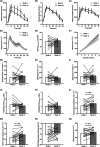A low n-6 to n-3 polyunsaturated fatty acid ratio diet improves hyperinsulinaemia by restoring insulin clearance in obese youth
- PMID: 35297549
- PMCID: PMC9177628
- DOI: 10.1111/dom.14695
A low n-6 to n-3 polyunsaturated fatty acid ratio diet improves hyperinsulinaemia by restoring insulin clearance in obese youth
Abstract
Aim: To examine the determinants and metabolic impact of the reduction in fasting and postload insulin levels after a low n-6 to n-3 polyunsaturated fatty acid (PUFA) ratio diet in obese youth.
Materials and methods: Insulin secretion and clearance were assessed by measuring and modelling plasma insulin and C-peptide in 17 obese youth who underwent a nine-point, 180-minute oral glucose tolerance test (OGTT) before and after a 12-week, eucaloric low n-6:n-3 polyunsaturated fatty acid (PUFA) ratio diet. Hepatic fat content was assessed by repeated abdominal magnetic resonance imaging.
Results: Insulin clearance at fasting and during the OGTT was significantly increased after the diet, while body weight, glucose levels, absolute and glucose-dependent insulin secretion, and model-derived variables of β-cell function were not affected. Dietary-induced changes in insulin clearance positively correlated with changes in whole-body insulin sensitivity and β-cell glucose sensitivity, but not with changes in hepatic fat. Subjects with greater increases in insulin clearance showed a worse metabolic profile at enrolment, characterized by impaired insulin clearance, β-cell glucose sensitivity, and glucose tolerance, and benefitted the most from the diet, achieving greater improvements in glucose-stimulated hyperinsulinaemia, insulin resistance, and β-cell function.
Conclusions: We showed that a 12-week low n-6:n-3 PUFA ratio diet improves hyperinsulinaemia by increasing fasting and postload insulin clearance in obese youth, independently of weight loss, glucose concentrations, and insulin secretion.
Keywords: adolescents; dietary lipids; fatty liver disease; glucose metabolism; insulin clearance; insulin metabolism; insulin resistance; insulin secretion; liver; obesity; β-cell function.
© 2022 The Authors. Diabetes, Obesity and Metabolism published by John Wiley & Sons Ltd.
Conflict of interest statement
The authors have no conflicts of interest pertinent to this study.
Figures



References
-
- Arslanian SA, Saad R, Lewy V, Danadian K, Janosky J. Hyperinsulinemia in african‐american children: decreased insulin clearance and increased insulin secretion and its relationship to insulin sensitivity. Diabetes. 2002;51(10):3014‐3019. - PubMed
-
- Meistas MT, Margolis S, Kowarski AA. Hyperinsulinemia of obesity is due to decreased clearance of insulin. Am J Physiol. 1983;245(2):E155‐E159. - PubMed
Publication types
MeSH terms
Substances
Grants and funding
LinkOut - more resources
Full Text Sources

